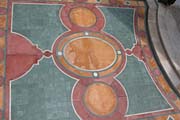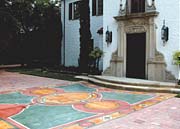

“The house was built in 1929,†said Vessels of the Dallas-based firm. “It's a Spanish Renaissance style with beautiful hand-carved limestone details. We had decided to make the front drive entry through the house more important. [The design] looks like a huge area rug. It has an Italian or Spanish style -- that 18th century look.â€
The designer explained that she researched in books to find appropriate styles for the decorative feature. The materials were then selected afterwards. Vessels worked closely with Horizon Italian Tile, also of Dallas, during the selection process. “We started talking about stones that had strength, and ones that were the right colors that we needed for the drive and could hold up in the Texas weather,†she said.
According to Olivia Boone, president of Horizon Italian Tile, the designer initially thought granite would be the best choice for the project. “She came in looking for granite and told me what colors she was looking for,†said Boone. “But, when I showed them to her, she didn't like them.†As a result, Boone presented Vessels with a number of other stones, explaining their strengths and weaknesses for this particular job. “She knew enough about what she shouldn't use because she knew which stones wouldn't hold up outdoors,†said the supplier.
After careful consideration and advisement from Boone, Vessels decided to use more than 30 slabs of honed Red, White and Jaisalmer Yellow Indian sandstone and honed Sea Foam Green slate and Noble Light quartzite -- both from Brazil -- for the design. The slabs, which varied in size from 3 x 6 feet to 5 x 7 feet, were cut with a waterjet and sent to the site. The design covered a 20- x 22-foot area.
“Once we got with Horizon Italian Tile and got the parameters settled, [these stones] had the best colors for what we wanted to do,†said Vessels. “They also worked for the application.â€
According to the designer, the entire driveway had been replaced. Surrounding the waterjet design are pavers resembling cobblestone. “It's antique looking with insets,†she said.
Vessels explained that one of the most challenging aspects of the project was coordinating everything. “We had to make sure that everyone understood our concept,†she said. “Also, finding the right source for the materials and finding the right installer was important.â€
To ensure that everything ran smoothly, Boone was on site everyday supervising. “The medallion was put on CAD after we took an accurate measurement of the space,†she explained. “We actually started out with the slate in slabs, but it began to buckle. We then decided to cut it up into 6- x 6-inch pieces. When we put it together, we saw that it became more interesting texturally. We developed [the design] as we went along.â€
The pieces were installed by Kemna Tile of Dallas, TX. “We haven't done anything quite like this, but we do a lot of pattern-type work,†said Barry Kemna of Kemna Tile. “We fabricate our own countertops here, and have done large pattern designs inside some homes.â€
The waterjet pieces arrived in boxes, according to Kemna. “We had a drawing provided from Horizon Italian Tile,†he said. “They had the pieces waterjet cut, and then we took them out of the box and laid them out.â€
According to the installer, one of the more difficult parts of the job was arranging the pieces to fit the pattern. “We dry laid it out on the ground, and re-fabricated some pieces to make it work,†said Kemna.
It took approximately three months for the pattern to be completed. A sand and cement mixture was used to install the stone pieces on a fresh mortar bed. The stone was then sealed.
In the end, the homeowners were happy with the result of their new decorative driveway, according to the designer. “I said to my client, 'Let's do something that hasn't been done before,'†said Vessels. “My client liked the suggestion.â€
